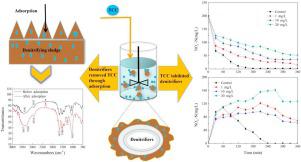Journal of Hazardous Materials ( IF 13.6 ) Pub Date : 2020-06-30 , DOI: 10.1016/j.jhazmat.2020.123343 Dongbo Wang 1 , Lingjuan Tao 1 , Jingnan Yang 1 , Zhengyong Xu 2 , Qi Yang 1 , Yi Zhang 1 , Xuran Liu 1 , Qiang Liu 1 , Jin Huang 3

|
The widespread use of triclocarban (TCC) has led to its substantial release into aquatic environment. As an important microbial community in wastewater treatment, denitrifying cultures likely remove TCC and also may be affected by TCC which has not been revealed. This work therefore aims to add knowledge to these questions. Experimental results showed that 71.2 %-79.4 % of TCC was removed by denitrifying sludge in stable operation when TCC concentration was 1∼20 mg/L. Mass balance analyses revealed that TCC was dominantly removed by adsorption rather than biodegradation, and non-homogeneous multilayer adsorption was responsible for this removal, with hydroxyl groups, amides and polysaccharides acting as the possible adsorption sites. Although the physicochemical properties of denitrifying cultures were unaffected after short-term exposure, long-term exposure to TCC deteriorated the settleability, dewaterability, flocculability and hydrophobicity of denitrifying biomass. It was observed that 20 mg/L TCC decreased denitrification efficiency by 70% in long-term operation. Mechanism studies revealed that long-term exposure to TCC resulted in the increase of extracellular polymeric substances especially proteins, and the decrease of denitrifiers’ activities. High-throughput sequencing revealed that TCC decreased the diversity of microbial community and the abundances of denitrifier genera such as Hyphomicrobium, Paracoccus, Saprospiraceae and unclassified-f-Rhodocyclaceae.
中文翻译:

了解三氯卡班与反硝化剂之间的相互作用。
三氯卡班(TCC)的广泛使用已导致其大量释放到水生环境中。作为废水处理中的重要微生物群落,反硝化培养物可能会去除TCC,并且还可能受到TCC的影响(尚未发现)。因此,这项工作旨在为这些问题增加知识。实验结果表明,当TCC浓度为1〜20 mg / L时,稳定运行的污泥反硝化去除了71.2%-79.4%的TCC。质量平衡分析表明,TCC的吸附主要是吸附而不是生物降解,而非均相的多层吸附是这种吸附的原因,羟基,酰胺和多糖是可能的吸附位点。尽管短期暴露后反硝化培养物的物理化学特性不会受到影响,长期暴露于TCC会使反硝化生物质的沉降性,脱水性,絮凝性和疏水性变差。观察到,在长期运行中,20 mg / L TCC使反硝化效率降低70%。机理研究表明,长期暴露于TCC会导致细胞外聚合物质(尤其是蛋白质)增加,反硝化剂活性下降。高通量测序表明,TCC降低了微生物群落的多样性和反硝化菌属的丰富度,例如 机理研究表明,长期暴露于TCC会导致细胞外聚合物质(尤其是蛋白质)增加,反硝化剂活性下降。高通量测序表明,TCC降低了微生物群落的多样性和反硝化菌属的丰富度,例如 机理研究表明,长期暴露于TCC会导致细胞外聚合物质(尤其是蛋白质)增加,反硝化剂活性下降。高通量测序表明,TCC降低了微生物群落的多样性和反硝化菌属的丰富度,例如生丝微菌属,副球菌,Saprospiraceae和非保密-F-Rhodocyclaceae。

























 京公网安备 11010802027423号
京公网安备 11010802027423号